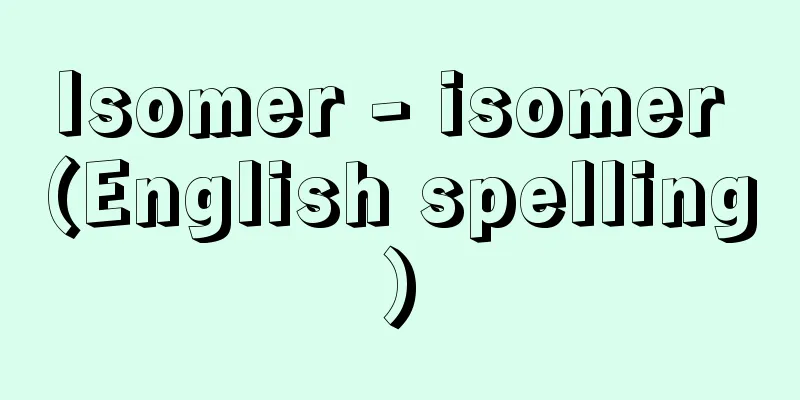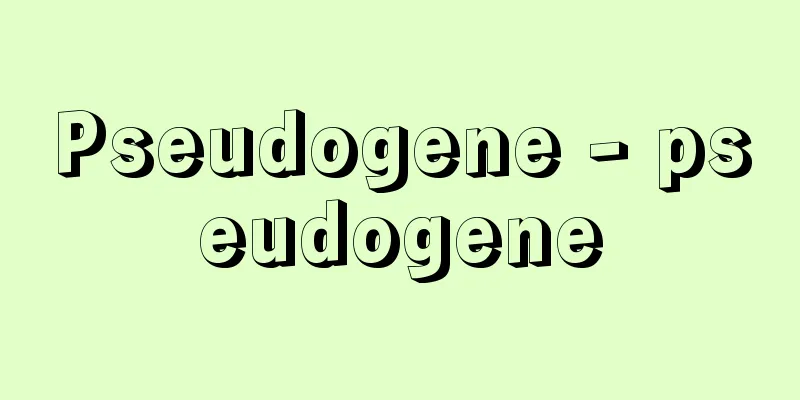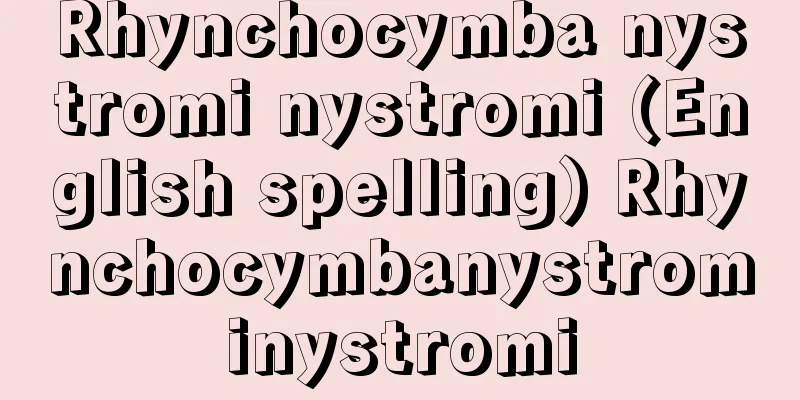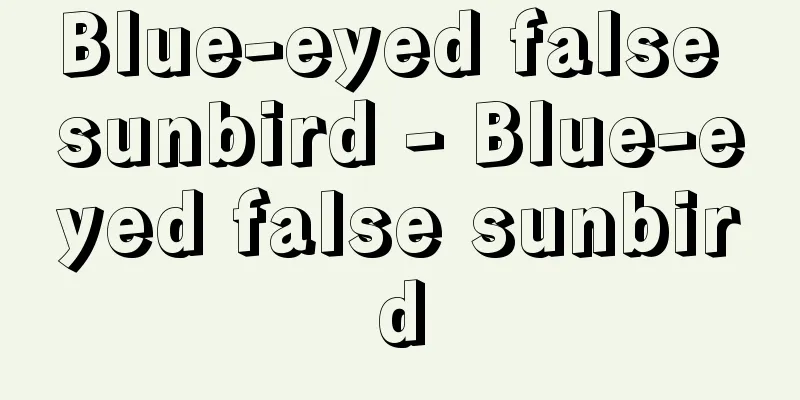Isomer - isomer (English spelling)

|
The existence of compounds with the same molecular formula but different properties is called isomerism, and compounds that are related by isomerism are called isomers. Isomerism is caused by structural differences in a broad sense, but is classified into several types depending on the structural characteristics. [Iwamoto Shinbu] historyIt originates from an anecdote that in the 1820s, F. Wöhler and J. Liebig of Germany independently synthesized silver cyanate AgOCN and silver fulminate AgONC, respectively, which initially sparked controversy, but later deepened their friendship after confirming that they were the first examples of isomers. Cyanate HOCN and fulminate HONC are examples of structural isomerism, with the same composition but different atomic bonding orders. In the mid-19th century, L. Pasteur of France separated the optical isomers of tartaric acid based on the characteristics of the external shape of the tartrate crystal, which led to the discovery of the tetrahedral bonding direction of carbon atoms. From the late 19th century to the early 20th century, A. Werner of Switzerland discussed the structure of cobalt(III) complexes based on the isolation of geometric and optical isomers, and proved the existence of an octahedral hexagonal structure, proposing the coordination theory. As such, research related to isomers has provided important experimental facts for the development of theories of chemical bonds and chemical structures. [Iwamoto Shinbu] Classification and structure of isomersIsomerism can be broadly divided into structural isomerism and stereoisomerism. (1) Structural isomerism Structural isomerism is an isomerism in which the chemical formula or molecular formula is the same, but the rational formula or the structural formula shown in one or two dimensions is different. Known structural isomerism includes chain isomerism due to the difference between the linear and branched structures of chain hydrocarbons, positional isomerism due to the difference in the position of the substituents, ring isomerism due to the difference in the bonding order of the atoms that make up the heterocycle, and functional isomerism such as in the case of ethanol (ethyl alcohol) and methyl ether. In the case of 1-butene, 2-butene, and isobutylene (2-methylpropene), which have different double bond positions, they can be considered as both positional isomerism and functional isomerism, even if isobutylene is excluded as a chain isomer ( ). As in this example, the classification of isomerism is a matter of convenience due to historical circumstances, and is not absolute. Although each isomer generally exists as a stable molecule or ion, there are cases where functional group isomers coexist as an equilibrium mixture through mutual conversion. Ethyl acetoacetate is a mixture of the keto form as ethyl acetoacetate and the enol form as ethyl 3-hydroxy-2-butenoate ( ). This type of isomerism is called tautomerism, and each compound is called a tautomer. (2) Stereoisomerism Stereoisomerism is the isomerism that occurs when the three-dimensional arrangement of atoms is different, even though the structural formula is the same. However, if we expand the definition of structural formula, there are also cases where stereoisomers can be distinguished by their structural formulas. This is called geometric isomerism. For example, fumaric acid and maleic acid cannot be distinguished from each other when shown in a one-dimensional structural formula, as they are CH(COOH)=CH(COOH), but they can be distinguished when shown in a two-dimensional structural formula. In fumaric acid, the carboxyl groups are located on opposite sides of the double bond, while in maleic acid, they are located on the same side. In general, the carboxyl groups on the same side of the double bond or an appropriate plane within the molecule are called cis and those on opposite sides are called trans, and the symbols cis- and trans- are used, respectively. Fumaric acid is a trans isomer, and maleic acid is a cis isomer ( ). Cis-trans isomerism is a type of geometric isomerism. In geometric isomerism of planar tetracoordinate and octahedral hexacoordinate metal complexes, cis often means "side by side" and trans often means "opposite sides". Optical isomerism is also a type of stereoisomerism, but it is an isomerism that occurs when the three-dimensional arrangement of atoms is in a relationship of real image and mirror image to each other, and when they are superimposed, they do not form the same structure ( ). Isomers in this relationship have almost identical physical and chemical properties, but they are distinguished by whether the plane of polarization of polarized light that passes through them rotates to the right (dextrorotatory) or to the left (levorotatory). In organic compounds, this isomerism occurs in those compounds in which all four types of atoms or atomic groups bonded to a carbon atom in a regular tetrahedral structure are different [Cabcd]. Such a carbon atom is called an asymmetric carbon atom, but there are also atoms other than carbon atoms that can be asymmetric, and the entire molecule can be asymmetric even if there is no atom in the center. For example, there are cases in which all the ligands are different in an octahedral 6-coordinate metal complex [Mabcdef], and in compounds that do not have the second type of symmetry element called molecular asymmetry, such as [Co(en) 3 ] 3+ or the helical chain structure of proteins. Various symbols are used to represent optical isomers, but the simplest way is to use the symbol (+) or d- for dextrorotatory and the symbol (-) or l- for levorotatory. [Iwamoto Shinbu] Rotational isomerismIn the isomers discussed so far, it has been assumed that the atomic groups connected by single bonds can rotate freely around the bond axis. However, the rotation is not always completely free. For example, in 1,2-dichloroethane, CH 2 Cl-CH 2 Cl, there are several stable and unstable configurations around the CC bond axis ( ). When the CC axis is viewed vertically, there are four relative configurations of each atom: trans, cis, and two types of gauche, and these are called rotational isomers. [Iwamoto Shinbu] [References] | | | | | | | | | | | |©Shogakukan "> Example of structural isomerism (Figure A) ©Shogakukan "> Example of tautomerism (Figure B) ©Shogakukan "> Example of geometric isomerism (Figure C) ©Shogakukan "> Example of optical isomerism (Figure D) ©Shogakukan "> Example of rotational isomerism (Figure E) Source: Shogakukan Encyclopedia Nipponica About Encyclopedia Nipponica Information | Legend |
|
分子式は同じになるが、性質の異なる化合物が存在することを異性isomerismといい、異性の関係にある化合物を異性体という。異性は、すべて広い意味での構造の差によって生ずるが、その構造的特徴に応じて、いくつかの種類に分類されている。 [岩本振武] 歴史1820年代にドイツのF・ウェーラーとJ・リービヒが、それぞれ独立にシアン酸銀AgOCNと雷酸銀AgONCを合成し、最初は論争となったが、のちにそれらが異性体の最初の例であることを確認して友情を深め合ったという逸話に端を発している。シアン酸HOCNと雷酸HONCとは、組成は同じであるが原子の結合順序が異なる構造異性の一例である。19世紀中ごろ、フランスのL・パスツールは酒石酸塩の結晶の外形に現れる特徴から、酒石酸の光学異性体を分割し、それが契機となって炭素原子の正四面体型結合方向の発見が導かれた。19世紀末から20世紀初めにかけて、スイスのA・ウェルナーはコバルト(Ⅲ)錯体の構造を幾何異性体と光学異性体の単離を根拠として論じ、八面体型6配位構造の存在を証明して配位説を提出した。これらのように、異性体が関係した研究は、化学結合や化学構造の理論の発展に重要な実験事実を提供してきた。 [岩本振武] 異性(体)の分類と構造異性は、構造異性と立体異性とに大別できる。 (1)構造異性 構造異性は、組成式あるいは分子式は同一であるが、示性式あるいは一次元的または二次元的に示される構造式が異なる異性である。鎖状炭化水素の直鎖状構造と分鎖状構造の違いによる鎖形異性、置換基の位置が異なる位置異性、複素環を構成する原子の結合順序が異なる環異性、エタノール(エチルアルコール)とメチルエーテルの場合のような官能基異性などの構造異性が知られている。二重結合の位置が異なる1-ブテン、2-ブテン、イソブチレン(2-メチルプロペン)の場合は、鎖形異性体としてイソブチレンを除いたにしても、位置異性とも官能基異性とも考えることができる()。この例のように、異性の分類は、歴史的事情も加わった便宜的なものであり、絶対的なものではない。 異性体のそれぞれは一般に安定な分子またはイオンとして存在することが多いが、官能基異性体どうしが互いに相互変換して共存する平衡混合物となっている例がある。アセト酢酸エチルは、アセト酢酸エチルとしてのケト形と、3-ヒドロキシ-2-ブテン酸エチルとしてのエノール形との混合物になっている()。このような異性を互変異性、それぞれの化合物を互変異性体とよぶ。 (2)立体異性 構造式は同じになるが、原子の立体的配置が異なるために生ずる異性を立体異性というが、構造式の定義を拡大すれば、立体異性とされるものも構造式によって区別できる例も含まれている。これを幾何異性という。たとえばフマル酸とマレイン酸は、一次元的構造式で示せばCH(COOH)=CH(COOH)となって区別できないが、二次元的に示せば区別できる。フマル酸は二重結合を挟んで互いに反対側にカルボキシ基が位置しており、マレイン酸では同じ側に位置している。一般に、分子内の二重結合あるいは適当な面を基準にして、同じ側にある場合をシス、反対側にある場合をトランスとよんで区別し、それぞれ記号cis-およびtrans-を用いる。フマル酸はトランス体、マレイン酸はシス体である()。シス‐トランスの異性は、幾何異性の一種である。平面型4配位および八面体型6配位金属錯体の幾何異性では、シスは「隣り合わせ」、トランスは「反対側」の意味になることが多い。 光学異性も立体異性の一種であるが、原子の三次元配列が互いに実像と鏡像の関係にあって重ね合わせても同一な構造にならないときにみられる異性である()。この関係にある異性体どうしは物理・化学的性質がほとんど同一であるが、それを通過した偏光の偏光面が右に回転するか(右旋性)、左に回転するか(左旋性)の違いによって区別される。有機化合物において、正四面体型構造をとる炭素原子に結合している4種の原子あるいは原子団がすべて異なるもの[Cabcd]ではこの異性現象が生ずる。その炭素原子を不斉(ふせい)炭素原子とよぶが、炭素原子以外でも不斉となる原子があり、中心に原子がなくても分子全体として不斉になることもある。たとえば、八面体型6配位の金属錯体で、すべての配位子が違う[Mabcdef]のような場合や、分子不斉といっている第2種の対称要素をもたない、たとえば[Co(en)3]3+あるいはタンパク質の螺旋(らせん)鎖構造などがそうである。光学異性体の表示法にはさまざまな記号が用いられているが、右旋性であれば(+)あるいはd-、左旋性であれば(-)あるいはl-の記号を用いるのがもっとも簡単な表記法である。 [岩本振武] 回転異性これまでに述べた異性体では、単結合で結合している原子団は、結合軸の周りで自由に回転できることを前提にしていた。しかし、その回転は完全に自由であるとは限らず、たとえば、1,2-ジクロロエタンCH2Cl-CH2Clでは、C-C結合軸の周りにはいくつかの安定な配置と不安定な配置とがある()。C-C軸を縦に見込んだときの各原子の相対的配置には、トランス、シス、ゴーシュ2種類の計4種類があり、これらは回転異性体rotational isomerとよばれる。 [岩本振武] [参照項目] | | | | | | | | | | | |©Shogakukan"> 構造異性の例〔図A〕 ©Shogakukan"> 互変異性の例〔図B〕 ©Shogakukan"> 幾何異性の例〔図C〕 ©Shogakukan"> 光学異性の例〔図D〕 ©Shogakukan"> 回転異性の例〔図E〕 出典 小学館 日本大百科全書(ニッポニカ)日本大百科全書(ニッポニカ)について 情報 | 凡例 |
<<: "Different Orders of Instruction" - Isei Teikininourai
>>: Western bottom trawl fishing boat - Iseisokobikiamigyosen
Recommend
underpinning
…This refers to construction work to reinforce th...
Musician - Ongyokushi
An entertainer who performs Japanese music, espec...
Hokkaido Chipmunk - Hokkaido Chipmunk
...in cold regions, they hibernate. There are no ...
Takashi Ishimoto
…During the Helsinki Olympics, he injured his kne...
Lysimachia
…A perennial plant of the Primulaceae family nati...
United Nations Convention on the Law of the Sea
⇒ United Nations Convention on the Law of the Sea ...
Weil, Adolf (English spelling) WeilAdolf
...An infectious disease caused by leptospirosis....
Kankomaru - Kankomaru
…In 1853 (Kaei 6), immediately after Perry's ...
Binche (English spelling)
A city in the province of Hainaut in southern Belg...
Modem (English)
A device used to send and receive data from one co...
Order parameters
…Normally, the temperature change of spontaneous ...
Atactic polypropylene
… [Stereoregular Polymerization] Monomers with vi...
Mobs
…Even in modern mass democracies, spontaneous col...
Fijian
...In the following, the same applies to Melanesi...
Horikawa Nami no Tsuzumi
Joruri Gidayubushi (play of the chanted chant). S...








![Educational Play - Lehrstück (English: Lehrstück) [Germany]](/upload/images/67cb5aaa9fa35.webp)
